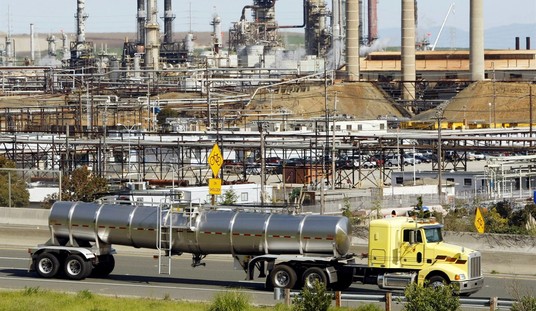The launch of the James Webb Space Telescope, named for the Apollo-era NASA administrator, has been eagerly anticipated by astronomers for years. It would allow scientists to view events and objects much further from earth and much further back in time than even the spectacular but aging Hubble. In fact, it is designed to see all the way back to the beginning of time.
Sadly, they may be disappointed. A couple months ago, Florida Today ran an exposé on the program, which is far behind schedule, with costs ballooning several hundred percent over the original estimates:
Decision-makers initially were told the observatory would cost $1.6 billion and launch this year on a mission to look deeper into space and further back in time than the Hubble Space Telescope, in a quest for new clues about the formation of our universe and origins of life.
NASA now says the telescope can’t launch until at least 2018, though outside analysts suggest the flight could slip past 2020. The latest estimated price tag: up to $6.8 billion. NASA admits the launch delay will push the bill even higher.
Sadly, as the paper points out in a follow-up editorial, this isn’t anomalous behavior at the space agency — it’s typical:
…the shuttle fleet and International Space Station both came in far behind schedule, weighed down by 45 percent increases from their original price estimates, according to the Government Accountability Office, the financial watchdog arm of Congress.
Ditto NASA’s Constellation moon program, which a presidential blue ribbon panel said was on a fiscally “unsustainable trajectory” that doomed it.
And, just recently, NASA said the new heavy-lift rocket [the Space Launch System, aka the Senate Launch System] it wants to send astronauts on future deep-space missions from Kennedy Space Center would cost $9 billion and come in two years behind its mandated 2016 completion date.
Now, the telescope problem has gotten even worse. Last week, Aviation Week reported that the latest cost estimates for the new telescope are now up to $8.7B, and it has kicked off an intra-agency fight for funds, pitting space science against human spaceflight:
The flagship observatory is currently funded entirely through NASA’s science division; now NASA is requesting that more than US$1 billion in extra costs be shared 50:50 with the rest of the agency. The request reflects administrator Charles Bolden’s view, expressed earlier this month, that the telescope is a priority not only for the science programme, but for the entire agency.
Unfortunately, there’s not enough money to spread around, particularly since the latest cost estimates for the Senate Launch System and new crew capsule have ballooned to almost forty billion (and that’s likely low).
The problem goes right to the top — the fish rots from the head down. Last fall, NASA Watch reported on the management mess that caused this:
The James Webb Space Telescope (JWST) project started under NASA Science Mission Directorate (SMD) Associate Administrator Ed Weiler. Virtually all of its chronic and unabated cost increases and schedule slips have occurred under Weiler’s watch either at NASA HQ or at NASA [Goddard Space Flight Center]. When former SMD [Associate Administrator] Alan Stern tried to bring the escalating costs of programs such as JWST and Mars Science Laboratory (MSL) under control, in 2008, multiple NASA sources note that [then-Deputy Administrator] Chris Scolese and Ed Weiler maneuvered to force Stern’s resignation, in a classic NASA “shoot the messenger” move, with Weiler taking Stern’s place within barely a week.
Note that both Scolese and Weiler still have their jobs. Administrator Bolden, despite the fact that he is a Marine general, seems reluctant to properly manage or discipline underperformers, even though they were not his appointments (the putsch described above occurred under NASA Administrator Mike Griffin). Ideally, the White House would deal with his own underperformance, but the last thing they want to do right now, amidst all their other problems, is a job search and confirmation for a new administrator.
But the agency cannot afford this. As the June editorial pointed out, this is NASA’s Katrina. The Webb telescope is eating up the budget for other space science projects, in an extremely austere fiscal environment. Moreover, NASA’s inability to control costs doesn’t inspire confidence that it will be able to execute future programs, such as the Senate Launch System, properly. And as the Florida Today article pointed out, this is an extremely complex and risky project from a technological standpoint. It is quite possible that, over a decade and several billion dollars from now, the device will be launched, and be an utter failure.
It is time — long past time — to pull the plug on this project, and start over with a clean sheet of paper and new assumptions. If SpaceX really develops their Falcon Heavy launcher, the capability to launch over fifty tons of payload at a cost of a hundred million dollars will revolutionize the way we think about payload design. It would relieve designers of the necessity to remove every last pound from a spacecraft, and allow innovative but less risky means of satisfying mission requirements. Moreover, if NASA is allowed to move forward with the technology development it seeks, and not have the budget for it eaten up by an unaffordable government launch vehicle for which there are no mission requirements or payloads, it will be possible to assemble large telescopes in orbit, and then move them the million or so miles to the planned observing site.
We are on the verge of a revolution in the costs and capabilities of spaceflight, and it is going to cause us to rethink a lot of the ways we currently do things. Putting off the capabilities of the Webb for a few years won’t be the end of the world for astronomy — the beginning of the universe isn’t going anywhere any time soon, and in any event, it looks as though such a delay is going to occur regardless, while wiping out a lot of other good science (some of which may have practical applications, such as prospecting asteroids for platinum group metals, or testing ways of moving one on a collision course for earth). In fact, it is quite likely that a new approach could give us the results of Webb, at lower cost, and sooner, but only if we abandon the current flawed one. But it would start with new management.
Let’s hope that the White House agrees.









Join the conversation as a VIP Member